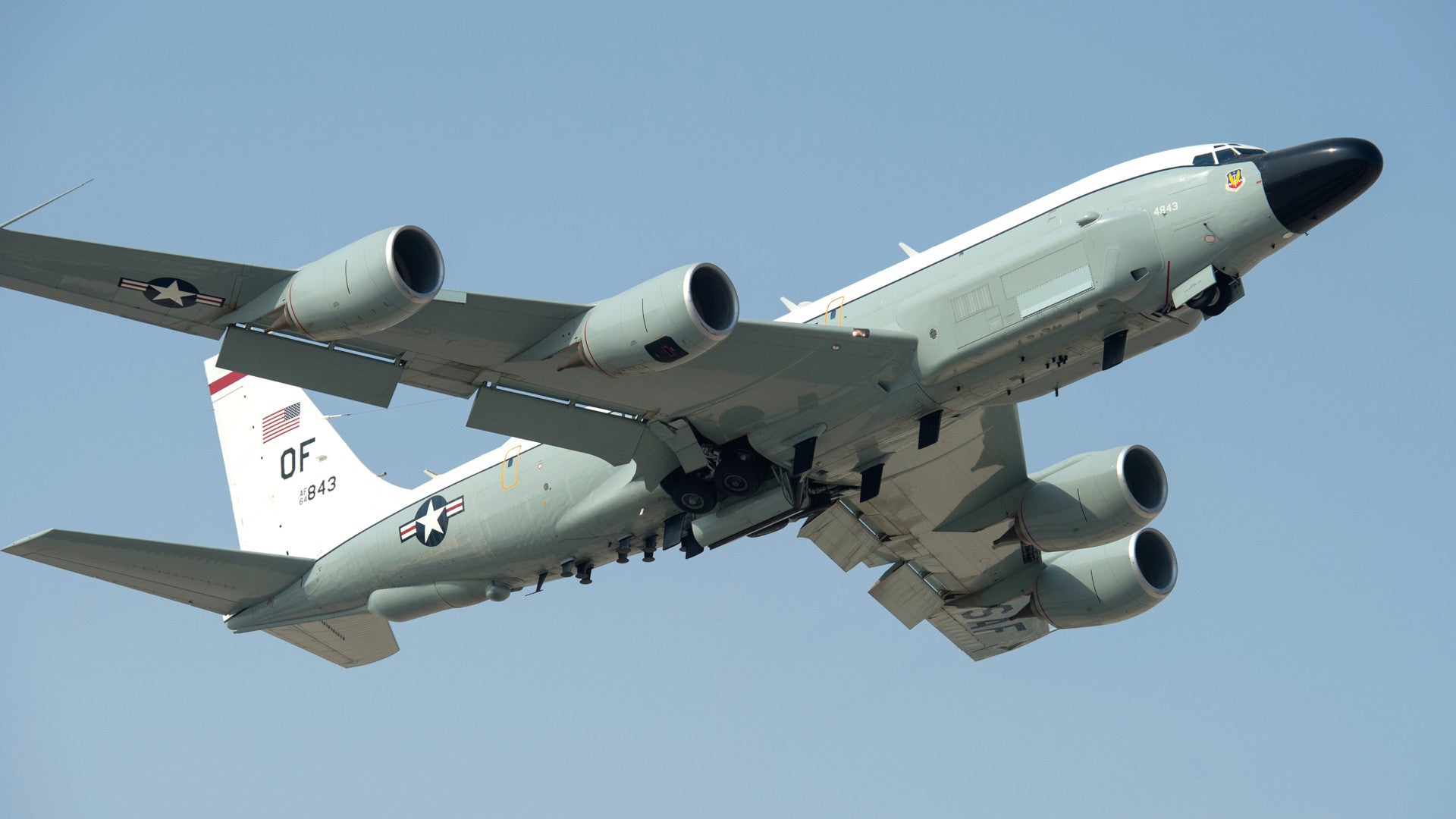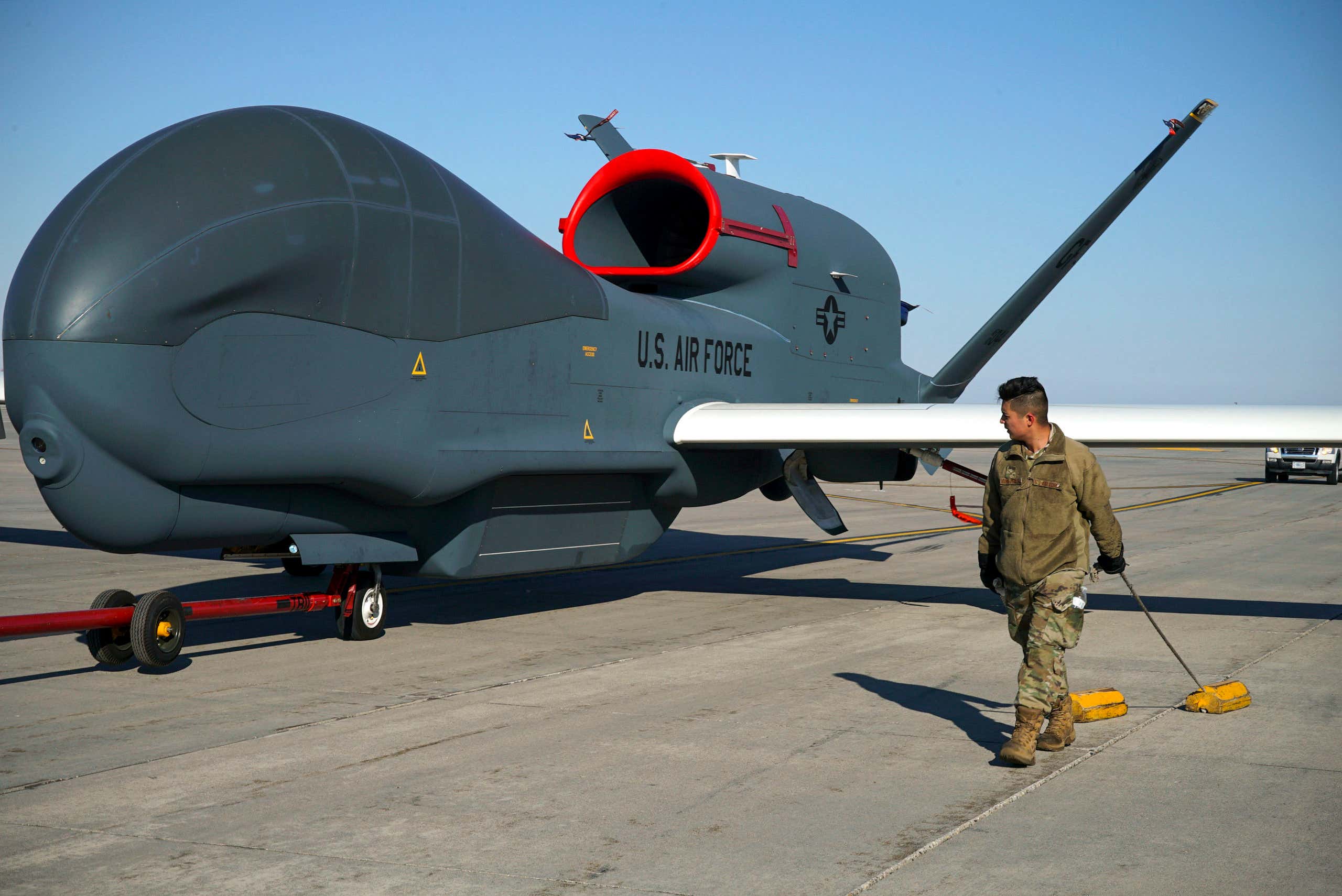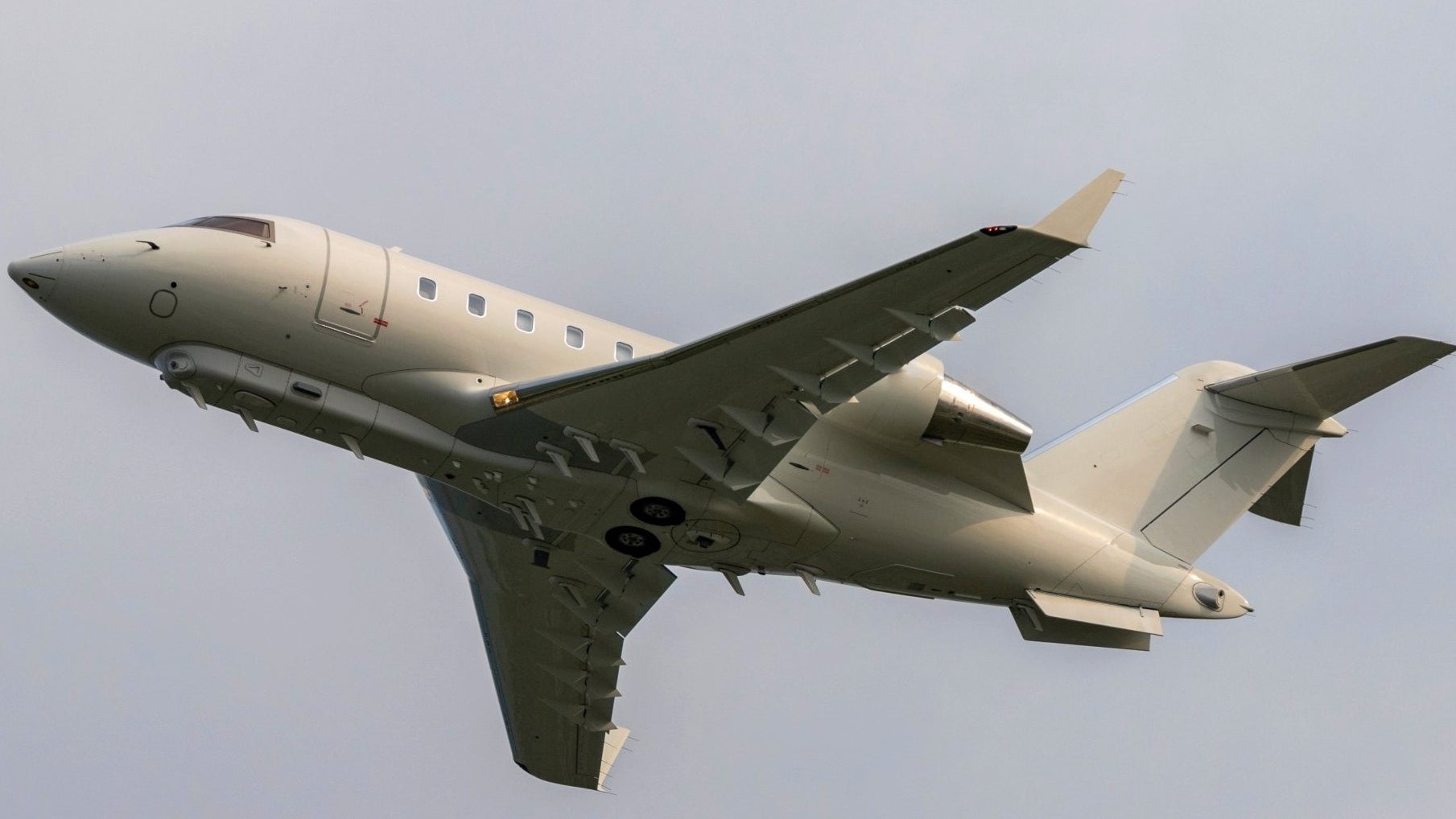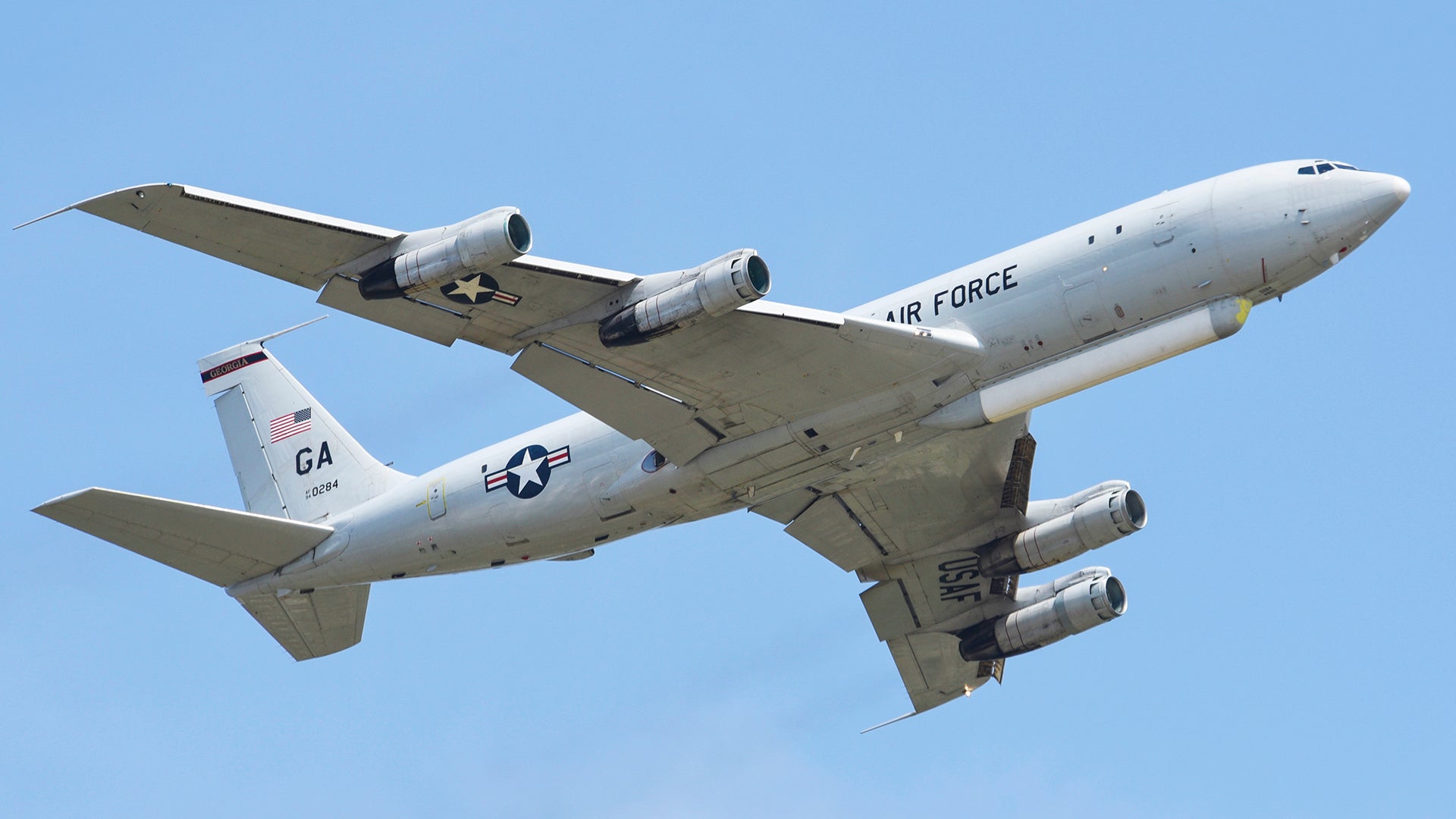Even as the U.S. Air Force gears up to start disposing of its fleet of E-8C Joint Surveillance Target Attack Radar System (JSTARS) aircraft, the reconnaissance asset is still providing critical intelligence, most recently directly over Ukraine. As concerns about a possible new Russian military intervention in that country persist, an E-8C appeared on December 27th, 2021, over the east of Ukraine. We cannot say for sure if this was the type’s debut mission over the area, we believe it’s possible that it has flown a similar profile before, but it certainly is first in recent times and especially since current tensions with Russia spiked.
A combination of publicly available flight-tracking data and a sharp-eyed photographer on the ground confirmed the presence of a single E-8C over Ukraine yesterday. The JSTARS, operating out of Ramstein Air Base in Germany, was using the callsign REDEYE6, and apparently flew several racetrack patterns over eastern Ukraine’s Donbas region, where Kyiv’s forces continue to battle Russian-supported forces in a long-running conflict. Should Moscow launch a large-scale invasion of Ukraine, it would primarily do so through this contested border region, as well as potentially along other vectors.
In another apparent first, the E-8C was joined on its Ukraine mission by an Air Force RC-135V Rivet Joint reconnaissance aircraft, callsign HOMER19, which was flying from Souda Bay on the Greek island of Crete. Publicly available flight-tracking information — which is not necessarily entirely precise — suggests the Rivet Joint was operating at times as close to 40 miles from territory occupied by Russian-backed forces.
However, the primary areas of interest for the U.S. intelligence-gathering aircraft would have been on the other side of the border, in Russian territory close to Ukraine. Here, according to official Ukrainian reports, there are around 100,000 Russian troops, while U.S. intelligence considers that figure to be closer to 70,000 troops. Either way, these forces are part of a major Russian military build-up in the region, which also includes heavy armor, artillery, and even long-range missiles, as well as air-defense systems.
The RC-135 has been noted over eastern Ukraine previously, although it is far from a regular practice, but the presence of both JSTARS and Rivet Joint suggests these platforms were operating together to best exploit their respective capabilities.
The E-8C is a battlefield management command-and-control aircraft that provides synthetic-aperture radar (SAR) imaging — which takes image-like radar maps of the ground environment at standoff ranges — and ground-moving-target-indicator (GMTI) functions used to track the movement of vehicles, in particular. These capabilities would clearly be invaluable to monitor the disposition of Russian forces close to the Ukrainian border, to get a better idea of Moscow’s intentions and capabilities, and provide very detailed intelligence as to all of it if Russia were to begin an offensive.

In contrast, the RC-135V is optimized for signals intelligence (SIGINT). It’s equipped with systems to geolocate and categorize radars and other systems associated with integrated air defenses, allowing the Rivet Joints to help build an accurate electronic order of battle, with the locations and types of enemy radars, communications nodes, electronic warfare systems, and other transmitters. The Rivet Joint is also capable of listening in on enemy communications chatter, which analysts and linguists onboard can then exploit in real-time before passing on to other units.
In this way, it’s easy to imagine the benefit of having an E-8C plot the movements of Russian vehicles, while the RC-135V hoovers up and locates communications while also identifying and classifying threat emitters and other radio frequency-dependent systems.

While the future of the RC-135 Rivet Joint fleet is secure, this is not the case for the E-8 JSTARS. Indeed, just days before REDEYE6 was flying its Ukraine mission, the Air Force confirmed its plans to dispose of four aircraft — a quarter of the JSTARS fleet — before September 2022. That move will begin the controversial retirement of the E-8C fleet, a long-running source of debate, with the aircraft being withdrawn without a direct replacement. In the defense budget request for the 2022 fiscal year, the Pentagon says the retirement of the first four JSTARS aircraft is part of wider efforts to “increase intelligence, surveillance, and reconnaissance (ISR) and command and control capability in a highly-contested environment.”
“New mission requirements and capabilities are already reimagining the … battlefield,” Col. Michelle Carns, commander of the 461st Air Control Wing, said in a statement last week, reported by Air Force Times.
At one point, it was expected that an all-new aircraft, based on a modern bizjet airframe, would replace the JSTARS, which entered service in the early 1990s, but use some of the oldest 707 airframes flying today.
In 2018, however, the JSTARS Recap program was canceled amid fears over the vulnerability of a manned successor with limited standoff ability in the face of the kinds of high-end air defenses being developed and fielded by China and Russia. The ranges from collection areas that a manned bizjet would need to be at to remain safe would make their sensors basically irrelevant. Instead, the Air Force ultimately decided that a system of systems-focused approach based around leveraging the Advanced Battle Management System (ABMS) would take the place of JSTARS.

ABMS began life partially as an element of a JSTARS successor, stressing ground and airborne target-tracking capabilities, but has since been further developed as a wide-ranging digital battle network system designed to collect, process, and share data among U.S. and allied forces in real-time. It involves multiple types of aircraft and satellites—all types of aircraft can be SAR and GMTI collectors today—but especially a new secretive family of aircraft that can penetrate into enemy airspace for collection, as well as types like the upcoming B-21 stealth bomber. There are also traditional strategic reconnaissance assets capable of GMTI and SAR collection that will remain in service but cannot penetrate enemy airspace, like the U-2 and Block 40 Global Hawk.
Ultimately, Robins Air Force Base in Georgia, currently the only facility with permanently based JSTARS aircraft, will host an important part of the ABMS network, with an air and space “fusion center” as well as “some remotely piloted aircraft … with sensors capable of collecting and transmitting information from the battlefield.”

With a mature ABMS network some way off in the future, lawmakers used the 2022 defense policy bill to warn that the Air Force that retiring JSTARS before a successor is fielded would result in a loss of critical intelligence-gathering capabilities. The same bill, which President Joe Biden signed yesterday, does not prohibit the Air Force from withdrawing the E-8C, however, and the service is now working toward that goal.
The U.S. Army now increasingly looks likely to step up its own airborne reconnaissance capabilities, which could also help fill the void left by the retirement of the JSTARS. Under its High Accuracy Detection and Exploitation System, or HADES, effort, the Army is planning on fielding a ground-surveillance radar with SAR and GMTI functions, essentially replicating some of the capabilities of the E-8C. You can read more about the HADES initiative here.

In the meantime, the JSTARS remains an in-demand asset to monitor global trouble spots, as evidenced by yesterday’s mission. While the Kremlin has warned the United States against deploying forces close to its borders, REDEYE6 and HOMER16 were both flying with their transponders on, making their progress visible to flight-tracking aggregators. While this would have alerted Moscow to the intent of the mission, flying with a transponder is likely a safety requirement over Donbas in particular, especially in light of the shoot-down of Malaysian Airlines Flight MH17 in July 2014. It also sends a signal to Russia that the U.S. is watching its movements very carefully. That intelligence can be quickly weaponized if need be.
As well as the symbolism of these surveillance planes operating so close to Russia, the United States has also been arming Ukraine with weapons including Javelin anti-tank missiles, a pair of refitted former U.S. Coast Guard patrol boats, and small arms. Furthermore, a small Pentagon team recently returned from Ukraine after a trip there to discuss and evaluate its air and missile defense needs. Bolstering these capabilities would be critical to responding to the air and missile strikes that would likely accompany any large-scale Russian intervention. It is also conceivable that any intelligence gathered by the Rivet Joint and JSTARS would also be passed on to Ukraine.
Russian claims that some of its troops have recently departed the region close to Ukraine’s border after completing planned exercises, this remains unconfirmed. With a series of talks between President Biden and his Russian counterpart Vladimir Putin planned for next month, the disposition of Moscow’s forces in the wider area remains a source of concern. With that in mind, the JSTARS — and Rivet Joint — fleets are likely to be on standby for further intelligence-gathering missions in the region.
Contact the author: thomas@thedrive.com
